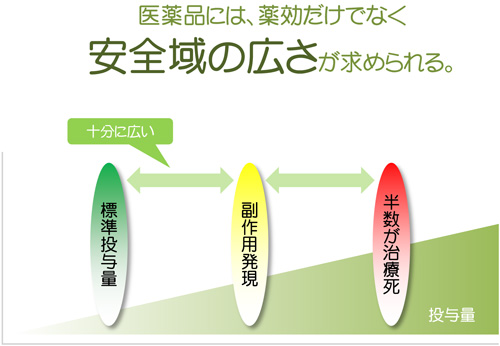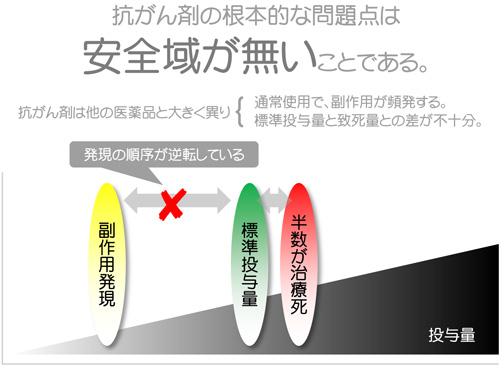目次
- 1 Why do Chemotherapeutic Agents Have Side Effects?
- 2 Comparing Conventional Medications, Hazardous Drugs, and Chemotherapeutic Agents
- 2.1 Conventional Medications – Drugs with a Wide Safety Margin –
- 2.2 Hazardous Drugs (Potent or Toxic Medicines) – Narrow Safety Margin –
- 2.3 Anticancer Drugs (Potent or Toxic Medicines) – No Safety Margin –
- 2.4 Anticancer Drugs Have No Safety Margin – Reversal of Effective Dose and Side Effect Dose
- 2.5 Combating Poison with Poison?
- 2.6 Common Misconceptions about Chemotherapy Drugs
- 3 Are Dogs and Cats Resistant to Chemotherapy Side Effects?
- 4 Enhancing the Effectiveness of Chemotherapy
- 5 Gaining Knowledge about Chemotherapy
- 6 Utilize Immune Power for Side Effect Management of Anti-cancer Drugs
Why do Chemotherapeutic Agents Have Side Effects?
Most likely, you are aware that chemotherapeutic agents are dangerous medicines. Many people also think, “I’m scared of the side effects.”
Indeed, chemotherapeutic agents often have many side effects, and sometimes these side effects can be so severe that they endanger the lives of dogs and cats.
Why does this happen? We will explain the reasons using diagrams.
These diagrams simplify the concepts to make them easy to understand. We also compare them with other medications to grasp the unique characteristics of chemotherapeutic agents.
In Japan, correct information about chemotherapeutic agents is not actively disseminated. As a result, Japan has become one of the leading nations in the use of chemotherapeutic agents, for better or worse.
It’s concerning to decide on chemotherapeutic treatment for your dog or cat based solely on explanations provided at the veterinary hospital. There’s simply not enough time during a consultation to receive a full explanation. Except in very urgent cases, do not make an immediate decision at the clinic; consult with your family and, if possible, consider getting a second opinion from another veterinarian. Never forget that chemotherapeutic treatment can sometimes lead to treatment-related fatalities.
Once you have taken your time to decide, gather information. While it is extremely difficult to find performance data for dogs and cats on the internet, data for humans is readily available. Since they are also mammals, this information can be very useful.
By understanding the content on this page, you will find it very helpful in organizing the information you gather.
Comparing Conventional Medications, Hazardous Drugs, and Chemotherapeutic Agents
Among the many pharmaceuticals, chemotherapeutic agents are particularly unique.
To understand how unique they are, refer to the following. Although it pertains to humans, the same applies to dogs and cats.
- Chemotherapeutic agents can be approved even if deaths have been reported in clinical trials. Therefore, deaths from toxicity or related infections during treatment are considered within the expected range of occurrences.
- Chemotherapeutic agents have an abnormally high rate of side effects, with an occurrence rate of over 70% being common and many agents having rates over 90%. Moreover, severe side effects are frequent, and in human cases, they are often not covered by side effect relief systems.
Since drugs are essentially toxic, there is no such thing as a completely safe medication, but no other drugs are as far from safe as chemotherapeutic agents.
Conventional Medications – Drugs with a Wide Safety Margin –
Examples of conventional medications are as follows:
Normal drugs have a wide safety margin, and side effects are rare within the typical usage range. Even if you accidentally administer ten times the amount, it is unlikely that a dog or cat would die from side effects.
The diagram below shows the relationship between the “effective dose,” “side effect dose (toxic dose),” and “lethal dose” for normal drugs.

Hazardous Drugs (Potent or Toxic Medicines) – Narrow Safety Margin –
The hazardous drugs mentioned here include the following:
Hazardous drugs have a narrow safety margin, and even a small mistake can lead to accidents. If your dog or cat accidentally ingests ten times the dose, it could be fatal.
Of course, if used cautiously at the normal dosage, accidents are unlikely. Generally, the benefits far outweigh the risks.
The diagram below illustrates hazardous drugs. The safety margin is much narrower compared to normal drugs.

Anticancer Drugs (Potent or Toxic Medicines) – No Safety Margin –
Looking at the characteristics of anticancer drugs in diagram form, their abnormality becomes apparent.
The reason for the frequent side effects at the standard dosage is clearly shown in the diagram below. Side effects occur even before reaching the typical therapeutic dose.
You will also notice that the standard dose is very close to the lethal dose when compared to other medicines. If you accidentally use ten times the dose, it will almost certainly result in death.

Anticancer Drugs Have No Safety Margin – Reversal of Effective Dose and Side Effect Dose
Anticancer drugs have no safety margin. In fact, the effective dose and side effect dose (toxic dose) are reversed.
Side effects begin to appear even at low doses, reaching toxic levels at the standard dosage. This characteristic is why side effects are so frequent even when administered at normal levels.
Reducing the dosage to avoid side effects renders the treatment ineffective. Therefore, these drugs are difficult to use flexibly.
Combating Poison with Poison?
Anticancer drugs are essentially toxic to the body. But can this poison (anticancer drug) truly combat another poison (cancer)?
The answer is NO.
While referred to as the standard dose, it does not imply a dose sufficient to completely eradicate cancer. It only provides limited effects, such as shrinking the cancer for a few weeks or alleviating symptoms. In some cases, this can result in prolonged survival.
The dose required to thoroughly eliminate cancer cells would likely exceed the lethal dose for dogs and cats. Even with cancer types like lymphoma that are highly responsive to anticancer drugs, complete eradication of cancer cells is impossible.
Reasons for the Proximity of Effective Dose and Lethal Dose
As mentioned previously, the standard dosage for chemotherapy drugs is not set at the “maximum amount to target cancer.” Instead, it is determined as the highest amount that dogs and cats can tolerate without being fatal.
This is why the effective dose and the lethal dose are adjacent, making it a delicate balance.
Common Misconceptions about Chemotherapy Drugs
Many of the following beliefs are generally misconceptions. One should not consider chemotherapy drugs in the same way as other medications.
- Because the drug is strong enough to cause death as a side effect, one can expect a corresponding level of effectiveness.
- If a drug causes side effects in 90% of cases, it should also have a 90% chance of improving the condition.
- There can’t be a drug with more disadvantages than benefits.
- Good medicine is bitter to the taste. One should endure even severe side effects.
- Since it is a drug approved in Japan, it should be safe to use.
- If everyone else is receiving it, it must be beneficial.
- If the veterinarian says it is good, there is no reason to doubt it.
- Since evidence has been provided, there’s no reason not to use it.
- Using chemotherapy drugs increases the chance of a miracle happening.
- I’ve heard that dogs and cats are less likely to suffer from side effects compared to humans.
Are Dogs and Cats Resistant to Chemotherapy Side Effects?
If dogs and cats were to vomit, it would likely be counted as a side effect. However, symptoms like “feeling queasy” or “something coming up” are often overlooked. Owners tend to feel relieved if their pets seem a bit energetic or eat slightly.
Additionally, the standard values for blood tests of dogs and cats are generally ambiguous compared to humans. There’s also the question of whether the same standard values are appropriate for both small and large breeds. We cannot exclude the possibility that abnormalities are being missed simply because they fall within the standard range.
Dogs, cats, and humans are all mammals. It’s hard to believe that the side effects are extremely minimal.
Enhancing the Effectiveness of Chemotherapy
You probably understand that chemotherapy alone cannot completely suppress cancer. Therefore, additional measures are essential to enhance the effectiveness of the treatment.
The side effects of chemotherapy are more pronounced when the physical strength of dogs and cats is low. Hence, they need to be given meals that help build their strength. Consider whether it is beneficial to continue giving kidney support food or gastrointestinal support food when fighting cancer, or if grain-based food could enhance their strength.
We put a high emphasis on the diet during cancer treatment.
Recommended Approaches for Dogs and Cats with Cancer – Low Carbohydrate, High Protein Diet
As their strength builds up, their immune function naturally improves. In cancer treatment, boosting the immune system is crucial, as it is the immune system that actually suppresses cancer. The immune system identifies and attacks cancer cells, and attempts to modify them to a less cancerous state, distinguishing clearly between normal and cancer cells without harming the body.
If chemotherapy is used, it should be strictly as a supplementary measure. The most critical factors are physical strength and immunity. Many owners seem to overlook this.
Please prioritize building your pet’s strength. If the pet has physical strength, it increases the likelihood of withstanding the side effects of the treatment.
Gaining Knowledge about Chemotherapy
Very few are well-versed in chemotherapy treatment. There are many who, upon being advised by a veterinarian to proceed with chemotherapy, simply follow through without a second thought.
However, to ensure that chemotherapy is genuinely beneficial for your dog or cat and to prevent leaving everything to the veterinarian, we have compiled the following articles for you to gain knowledge about chemotherapy. Please take the time to read them.
- About Chemotherapy Used in Dog and Cat Cancer Treatment – Side Effects, Precautions, and More
- About Molecular Targeted Drugs Used in Dog and Cat Cancer Treatment
- Types and Protocols of Chemotherapy and Chemotherapeutic Agents Used in Lymphoma Treatment for Dogs and Cats
- Trace Exposure to Anti-cancer Drugs – Beware of Chemotherapy Drugs during Pet Cancer Treatment
- Why 90% of Anti-cancer Drug Side Effects Manifest
- Being Recommended Chemotherapy for Dogs and Cats, but What About the Risk of Side Effects?
Utilize Immune Power for Side Effect Management of Anti-cancer Drugs
Undergoing chemotherapy almost inevitably results in side effects. Even if the tumor shrinks, it is difficult to maintain the quality of life for dogs and cats if they are debilitated by side effects.
At the Cordy Laboratory, we are researching whether administering Cordy can boost immune strength to mitigate side effects or aid in faster recovery from the damage caused by side effects. Additionally, there is a risk of liver function decline during chemotherapy. Our laboratory is also studying whether the combination of Cordy, which has immune-modulating properties, and Placenta Extract Powder from Domestic SPF Pigs can reduce side effects and improve quality of life (QOL).
If you have any questions, please feel free to contact us.
※ We are also researching the application of Cordyceps, a specific type of fungus, to humans for its potential immune-regulating functions.
- Dog Cancer (Tumor) – Symptoms, Tests, Surgery, Treatment, Diet, Tips for Improving and Curing Cancer
- Cat Cancer (Tumor) – Symptoms, Tests, Surgery, Treatment, Diet, Tips for Improving and Curing Cancer
- Cat Malignant Lymphoma – Tips for Smiling Even During Lymphoma Treatment
- Dog Malignant Lymphoma – For Overcoming Malignant Lymphoma, Improving Quality of Life, and Extending Lifespan

この記事が気に入ったら
いいね ! しよう
サイト内検索





